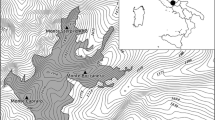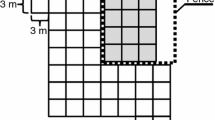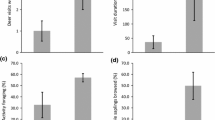Summary
I. aggregata exhibits considerable powers of regrowth following removal of its primary shoot by herbivores, but we found no evidence of overcompensation (i.e. of significantly higher plant performance where plants were exposed to ungulate herbivory) in a comparison between individuals on grazed and ungrazed sides of exclosure fences, in a comparison between artificially clipped and control plants in one population in the Okanagan National Forest, or in comparisons between grazed and ungrazed plants in 14 natural populations. We tested whether ungulate grazing affects the population size of Ipomopsis aggregata by comparing populations inside and outside deer exclosures at 7 sites in the Western United States. We found consistent, highly significant differences in plant population density on the grazed and ungrazed sides of these exlosure fences. Plant density was a modal 25-fold higher on the protected side of the fence, suggesting that exposure to ungulate grazing increases plant death rates at some stage in the life cycle. Our results show that the presence of ungulate grazers leads to a substantial decrease in plant density despite the fact that grazing on young bolting shoots has very little influence on fruit production. Since this decrease in population density is not correlated with a decrease in the fecundity of individuals, it must instead be due to other direct and indirect effects of ungulate grazers.
Similar content being viewed by others
References
Abrams L, Ferris RS (1959) Vegetation and Flora of the Pacific States. Stanford University Press. California
Belsky AJ (1986) Does herbivory benefit plants? A review of the evidence. Am Nat 127:870–892
Bergelson J, Crawley MJ (1992) Overcompensation in response to mammalian herbivory: the disadvantage of being eaten. Am Nat 139
Bentley S, Whiffaker JB (1979) Effects of grazing by a chrysomelid beetle Gastrophysa viridula on competition between Rumex obtusifolius and R. crispus. J Ecology 68:671–674
Charlesworth B (1980) Evolution in Age-Structured Populations. Cambridge University Press, Cambridge
Crawley MJ (1983) Herbivory. The Dynamics of Animal Plant Interactions, Blackwell Scientific Publications. Oxford
Crawley MJ, Pacala SW (1991) Herbivores, plant parasites and plant diversity In: C Toft (ed) Parasitism: Coexistence or Conflict? Oxford University Press, Oxford
Grant V, Wilken DH (1986) Taxonomy of the Ipomopsis aggregata group (Polemoniaceae). Bot Gaz 147:359–371
Hainsworth FR, Wolf LL, Mercier T (1985) Pollen limitation in a monocarpic species, Ipomopiss aggregata. J Ecology 73:263–270
Hitchcock CL, Cronquist A (1973) Flora of the Pacific Northwest. University of Washington Press. Seattle
McNaughton SJ (1986) On plants and herbivores. Am Nat 128:765–770
Munz PA (1959) A California Flora. University of California Press
Paige KN, Whitham TG (1987a) Overcompensation in response to mammalian herbivory: the advantage of being eaten. Am Nat 129:407–416
Paige KN, Whitham TG (1987b) Flexible life history traits: shifts by scarlet gilia in response to pollinator abundance. Ecology 68:1691–1695
Smith CC, Fretwell SD (1974) The optimal balance between size and number of offspring. Am Nat 108:499–506
Verkaar HJ (1986) When does grazing benefit plants. Trend Ecol Evol 1:168–169
Williams GC (1975) Sex and Evolution. Princeton University Press, Princeton
Author information
Authors and Affiliations
Rights and permissions
About this article
Cite this article
Bergelson, J., Crawley, M.J. The effects of grazers on the performance of individuals and populations of scarlet gilia, Ipomopsis aggregata . Oecologia 90, 435–444 (1992). https://doi.org/10.1007/BF00317703
Received:
Accepted:
Issue Date:
DOI: https://doi.org/10.1007/BF00317703




